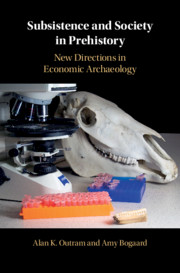Book contents
- Subsistence and Society in Prehistory
- Subsistence and Society in Prehistory
- Copyright page
- Dedication
- Contents
- Figures
- Table
- Preface
- Chapter 1 Introduction
- Chapter 2 Is Determinism Dead?
- Chapter 3 Incorporating New Methods I: The Stable Isotope Revolution
- Chapter 4 Incorporating New Methods II: Residue Chemistry
- Chapter 5 Incorporating New Methods III: Answering Palaeoeconomic Questions with Molecular Genetics
- Chapter 6 Incorporating New Methods IV: Phytoliths and Starch Grains in the Tropics and Beyond
- Chapter 7 Integrated Case Study I: Early Farming in Central Europe
- Chapter 8 Integrated Case Study II: Horse Domestication and the Origins of Pastoralism in Central Asia
- Chapter 9 Conclusion
- References
- Index
- References
References
Published online by Cambridge University Press: 03 October 2019
- Subsistence and Society in Prehistory
- Subsistence and Society in Prehistory
- Copyright page
- Dedication
- Contents
- Figures
- Table
- Preface
- Chapter 1 Introduction
- Chapter 2 Is Determinism Dead?
- Chapter 3 Incorporating New Methods I: The Stable Isotope Revolution
- Chapter 4 Incorporating New Methods II: Residue Chemistry
- Chapter 5 Incorporating New Methods III: Answering Palaeoeconomic Questions with Molecular Genetics
- Chapter 6 Incorporating New Methods IV: Phytoliths and Starch Grains in the Tropics and Beyond
- Chapter 7 Integrated Case Study I: Early Farming in Central Europe
- Chapter 8 Integrated Case Study II: Horse Domestication and the Origins of Pastoralism in Central Asia
- Chapter 9 Conclusion
- References
- Index
- References
- Type
- Chapter
- Information
- Subsistence and Society in PrehistoryNew Directions in Economic Archaeology, pp. 209 - 264Publisher: Cambridge University PressPrint publication year: 2019



